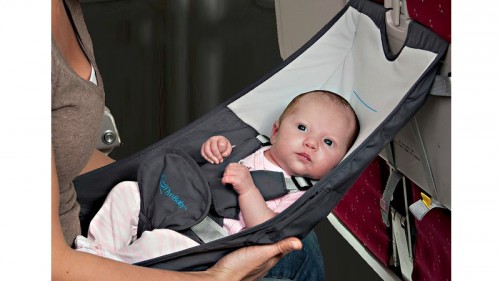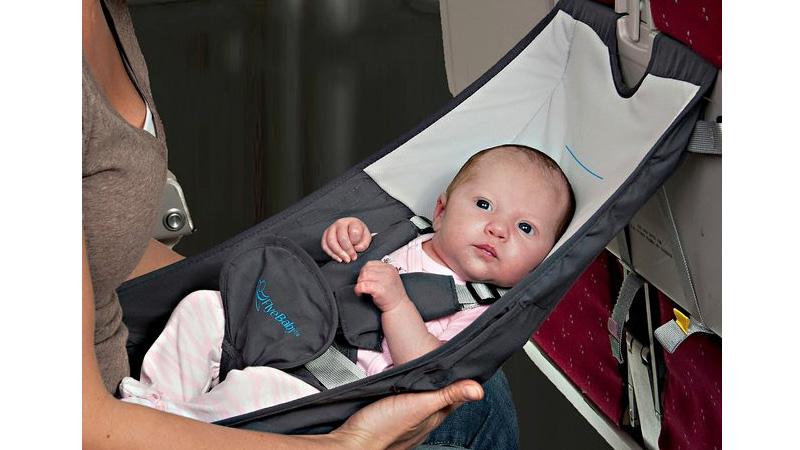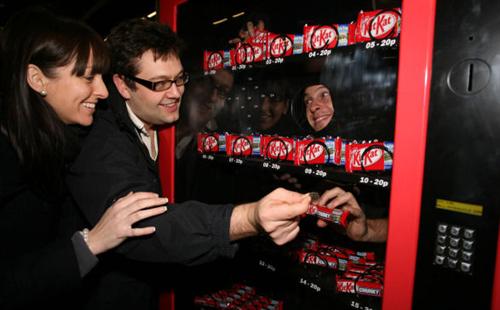
By David Ponce
As Andrew points out in his article, overhead compartments are not acceptable places in which to put a baby during flight. Nor is the cargo hold, surprisingly. Which means you’re left with the task of caring for this little human for what could be a long arduous flight. Any help is appreciated and the FlyeBaby Hammock is a start. Featuring a five-point harness system, it attached to the tray table in front of most airplane seats and to either side of you. You can then place baby right in front of you and interact with him during the cruise portion of the flight. This might help reduce the crying, which will make you a more popular parent. It follows FAA regulations and as long as it’s not used during taxiing, landing and takeoff, it shouldn’t be seen as a problem in any situation. There’s a line on the hammock that signifies the highest baby should be placed in case the person in front of you decides to recline; this will prevent baby’s head from being hit as this happens.
It’s $45 and available now. It’s actually been available for some time, but hey, first for us could mean first for some of you too!
[ Product Page ] VIA [ Gizmodo ]






Anyone who does not see the inherent risks involved here is as blind as this products’ creators! Sure the seat will recline slowly… if the person in front is under 100 kg’s and not top-heavy. If they aren’t, you should expect the seat to come back faster than you can react and adjust your FlyeBaby. Who else can see baby getting a little cramped here? Now the parents get upset at the person in front and you have a conflict that would not have happened had they not been using this poorly designed product.
If you have adjusted for the seat in front being reclined, then the person in front; be they inconsiderate or just forgetful, decides to incline again, you get tugged and pulled, so does baby, and then our friend in front gets annoyed that you are tethered to the back of their seat and will either ask you not to continue using the product, or possibly never agree to it again in future. This could be awkward at the very least not to mention an inconvenience that another full fare passenger shouldn’t have to deal with.
On that note – I would like to know who has tested the load-bearing capacity on the catch for the tray table? Personally I’ve seen these catches broken on flights I’ve been on – which isn’t a lot of flights by most standards, which then begs these questions; How often do they break? Are they designed to take the weight of baby, and possibly the shifting weight of the parent tethered to the FlyeBaby and any other incidental or accidental tugs and pulls? This would likely be considered an unknown quantity by any technician trying to assess the impact of a baby of unknown weight and proportion, on a hammock strung across from tray table to parent of unknown weight and proportion, and quickly dismissed as a very bad idea.
One would assume that the catch is likely to be designed only to hold an empty tray table in an upright position. A tray table made of plastic and aluminium, weighing a lot less than a baby and in an UPRIGHT position, not strung across to the parent and absorbing the stress of their every movement.
IMHO it won’t be the FAA that bans this product, it will be the airline companies after a few hundred tray table catches are broken in the first hit of turbulence!
Oh! Turbulence! That reminds me… not to be used during turbulence. Sure the pilot gives you the heads up if and when they can, but please raise your hand if you’ve actually been on a flight where turbulence didn’t occur unless the pilot said it would?
This product should go back to a professional drawing board, not Grandpa’s shed.
Really like the effort of the Ohgizmo staff to expand tech and gizmo news beyond electronics, it makes the blog diverse and interesting.
On the product itself, yeah, I agree with a lot of peterb’s points, I don’t see this working, not even if I could get a seat that has that much legroom